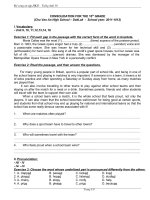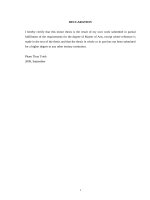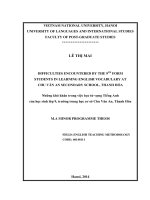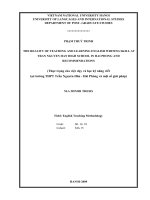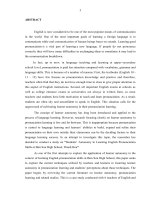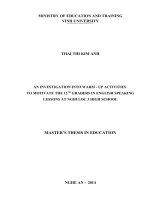TEACHING AND LEARNING ENGLISH WRITING SKILLS AT CHU VAN AN HIGH SCHOOL FOR THE GIFTED LANG SON PROVINCE DIFFICULTIES AND SOLUTIONS
Bạn đang xem bản rút gọn của tài liệu. Xem và tải ngay bản đầy đủ của tài liệu tại đây (292.02 KB, 66 trang )
VIETNAM NATIONAL UNIVERSITY, HANOI
UNIVERSITY OF LANGUAGES AND INTERNATIONAL STUDIES
FACULTY OF POST - GRADUATE STUDIES
*************************
DƯ ÁI HUỆ CHI
TEACHING AND LEARNING ENGLISH WRITING SKILLS AT CHU
VAN AN HIGH SCHOOL FOR THE GIFTED, LANG SON
PROVINCE: DIFFICULTIES AND SOLUTIONS
(VIỆC DẠY VÀ HỌC KỸ NĂNG VIẾT TẠI TRƯỜNG THPT CHUYÊN
CHU VĂN AN, LẠNG SƠN: NHỮNG KHÓ KHĂN VÀ GIẢI PHÁP)
M.A. MINOR PROGRAMME THESIS
Field : English Teaching Methodology
Code : 60140111
Hanoi, 2015
VIETNAM NATIONAL UNIVERSITY, HANOI
UNIVERSITY OF LANGUAGES AND INTERNATIONAL STUDIES
FACULTY OF POST - GRADUATE STUDIES
*************************
DƯ ÁI HUỆ CHI
TEACHING AND LEARNING ENGLISH WRITING SKILLS
AT CHU VAN AN HIGH SCHOOL FOR THE GIFTED, LANG SON
PROVINCE: DIFFICULTIES AND SOLUTIONS
(VIỆC DẠY VÀ HỌC KỸ NĂNG VIẾT TẠI TRƯỜNG THPT CHUYÊN
CHU VĂN AN, LẠNG SƠN: NHỮNG KHÓ KHĂN VÀ GIẢI PHÁP)
M.A. MINOR PROGRAMME THESIS
Field : English Teaching Methodology
Code : 60140111
Supervisor : Assoc. Prof. Dr. Kiều Thị Thu Hương
Hanoi, 2015
STATEMENT OF THE AUTHORSHIP
I hereby certify that the minor thesis entitled “Teaching and Learning English
Writing Skills at Chu Van An High School for the Gifted, Lang Son Province:
Difficulties and Solutions” is the result of my own study to fulfill the requirements
for the Degree of Master of Arts at College of Foreign Languages, Hanoi National
University, and that this minor thesis has not been submitted for any degree at any
other university or tertiary institution.
Hanoi, September 2015
Du Ai Hue Chi
i
ACKNOWLEDGEMENTS
I am indebted to many people without whose help the present thesis could not have
been completed. First of all, I would like to express my sincere gratitude to Dr. Kieu
Thi Thu Huong, my research supervisor, for her invaluable guidance, insightful
comments and endless support.
I am deeply thankful to Dr. Le Hung Tien and all the staff members of the Post
graduate Department, College of Foreign Languages, Hanoi National University for
their interesting and informative lectures, which have provided me with useful
knowledge of teaching methodology.
My thanks are also extended to all the teachers and students at Chu Van An High
School for the Gifted, Lang Son province for their enthusiastic assistance during the
process of collecting data and information for my study.
My special thanks are due to the library staff at ULIS for their tremendous efforts in
finding books and journal articles for me.
Finally, I owe the completion of this research to my parents and my siblings, my
husband and my child, who have always given me their love, understanding and
encouragement throughout my study.
To all mentioned, and to many more, my heart extends the warmest thanks.
ii
ABSTRACT
This study is an attempt to explore the reality of the teaching and learning English
writing skills at Chu Van An High School for the Gifted in Lang Son Province. It
aims at affording deep insights into the difficulties encountered by the tenth graders
in their learning of writing. Such issues as the teachers' and students' attitudes
towards writing, the students' writing strategies and the students' writing training are
carefully examined on the basis of the data obtained from elicited written
questionnaires and class observation. The findings exhibit that students have to face
many difficulties in three writing stages: Pre-writing, While-writing and Post-
writing. These difficulties are not only due to the teachers' and students' negative
attitudes towards writing but also the shortcomings in the students' writing
strategies and training. Based on those findings, the study provides some
pedagogical suggestions to overcome the difficulties.
iii
LIST OF ABBREVIATIONS
1. EFL: English as a foreign language
2. ESL: English as a second language
3. CVA: Chu Van An High School for the Gifted, Lang Son Province
iv
LIST OF TABLES AND CHARTS
Tables
Table 1: Differences between the process writing and the product writing
Table 2. Topics and text types in each unit of English 10
Table 3. Students' writing strategies
Table 4. The number of drafts
Table 5. Students' rewriting strategies
Table 6. Students' judgment of their Pre-writing difficulties
Table 7. Students' judgment of their While-writing difficulties
Table 8. Students' judgment of their Post-writing difficulties
Table 9. Frequency of activities used by teachers in Pre-writing
Table 10. Frequency of activities used by teachers in While-writing
Table 11. Frequency of activities used by teachers in Post-writing
Charts
Chart 1. The most difficult skills to learn
Chart 2. How much the students like learning writing
Chart 3. The most difficult skill to teach
Chart 4. How much the teachers like teaching writing
v
TABLE OF CONTENTS
Statement of the authorship i
Acknowledgements ii
Abstract iii
List of abbreviations iv
List of tables and charts v
Table of contents vi
PART A: INTRODUCTION
1. Rationale of the study 1
2. Aims of the study 2
3. Research questions 2
4. Methods of the study 2
5. Scope of the study 2
6. Significance of the study 2
7. Organization of the study 3
PART B. DEVELOPMENT
CHAPTER 1. LITERATURE REVIEW
1.1. Definition of writing 4
1.2. Fundamental components of writing 5
1.3. Problems caused by writing 5
1.4. Differences between skilled and unskilled writers 7
1.5. Approaches to teaching writing
1.5.1. Controlled-to-free approach 8
vi
1.5.2. Free writing approach 8
1.5.3. Paragraph-pattern approach 9
1.5.4. Grammar-syntax-organization approach 9
1.5.5. Communicative approach 10
1.5.6. Process approach 11
1.5.7. Product-oriented approach 12
1.5.8. Summary of the differences between product and process pproaches.
13
CHAPTER 2. RESEARCH METHODOLOGY
2.1. Context of the study 16
2.1.1. The school 16
2.1.2. English 10 Textbook 16
2.1.3. The writing section in English 10 textbook 16
2.2 Research questions 18
2.3 Research methods 18
2.3.1 Participants. 19
2.3.2 Instruments and procedure 19
CHAPTER 3. DATA ANALYSIS AND DISCUSSION
3.1. Analysis of the questionnaire for students 21
3.1.1. Students' attitude towards writing 21
3.1.2. Students' writing strategies 22
3.1.2.1. Students' writing strategies 22
3.1.2.2. Students' rewriting strategies 22
vii
3.1.3. Students' judgment of their writing difficulties 23
3.1.3.1. Students' difficulties in Pre-writing stage 23
3.1.3.2. Students' difficulties in While-writing stage 24
3.1.3. 3. Students' difficulties in Post-writing stage 25
3.2. Analysis of the questionnaire for teachers 25
3.2.1. Teachers' attitude towards teaching writing 25
3.2.2. Learners' training in writing 26
3.2.2.1 Frequency of activities used by teachers in Pre-writing 26
3.2.2.2. Frequency of activities used by teachers in While-writing 28
3.2.2.3. Frequency of activities used by teachers in Post-writing 29
3.3. Class Observation 30
PART C. CONCLUSION
4.1. Study findings 32
4.1.1. Students' difficulties in learning writing 32
4.1.2. Reasons for the difficulties 32
4.1.2.1. Negative attitude towards writing 32
4.1.2.2. Shortcomings in the students' strategies and training 32
4.2. Suggestions for the solution 34
4.2.1 Create and maintain a positive atmosphere for learning 34
4.2.2. Take advantage of the 'out-of-book' lessons 34
4.2.3. Give students ownership and publishing 35
4.2.4. Engage students in writing regularly 35
4.2.5. Provide students with constructive response and guide them how to
offer response to other writes 36
viii
4.2.6. Provide opportunities for students to collaborate as writers 36
4.3. Limitations 37
4.4. Suggestions for further study 37
REFERENCES 38
APPENDIX
Appendix 1: Survey Questionnaire for Students I
Appendix 2: Survey Questionnaire for Teachers V
Appendix 3: Observation Description VII
ix
PART A. INTRODUCTION
1. Rationale of the study
Nowadays, communication across languages and cultures has become more
important than ever before. The ability to speak, listen, read and write in a foreign
language is widely recognized as a vital skill for professional and educational
purposes. This results in an increasing demand for teaching and learning foreign
languages, among which teaching and learning English holds a dominant position
at all levels of education in Vietnam.
Although English language teaching and learning in Vietnam has taken its own
priority, the education quality has not met expectations of Vietnamese Ministry of
Education and Training and the local people. This is certainly due to many reasons
but it is, to some extent, due to the ways of teaching and learning that are said
evidently to focus on theory rather than real practice. This results in the reality that
a large majority of high-school students lack communicative competence. They
can not communicate in English successfully and effectively in both oral and
written forms, in which the written form is considered to be the bigger challenge.
For many Vietnamese students, writing is the most intricate and complex skill that
challenges their ability. It is not uncommon to see that Vietnamese high-school
learners with at least four-year experience of learning English in secondary school
have considerable difficulty when they have to write communicatively in the target
language. Even the students who go to English speaking countries for advanced
study and have scored high in TOFEL initially cope with difficulties in writing.
The question raised here is what teachers should do to help students overcome
their problems in writing.
As a teacher of English, I am full aware of difficulties facing teachers and learners
when teaching and learning writing skills and wish to make a contribution to
improve the teaching and learning of writing skills at the school, which I have been
1
working for, as well as at other high schools in my local area.
2. Aims of the study
The main purpose of the study is to research the reality of teaching and learning
English writing skills to the tenth graders at Chu Van An High School for the
Gifted, Lang Son Province (henceforth CVA) on the basis of finding out the
difficulties encountered by the learners in three writing stages: Pre-writing, While-
writing and Post-writing. The other purpose of the study is to propose some
suggestions to deal with the difficulties.
3. Research questions
1) What difficulties do the tenth graders at CVA encounter when
learning English writing skills?
2) What are the reasons for the difficulties?
3) What are the possible solutions to overcome the difficulties?
4. Methods of the study
This is a survey study in which both quantitative and qualitative methods have
been employed. To collect information and data, two instruments: questionnaires
and class observation have been used. In addition, reviewing related documents is
a method to establish the theoretical background for the study.
5. Scope of the study
This minor thesis has been conducted at CVA in order to recognize difficulties
encountered by the tenth graders in three writing stages. Explanations for the
difficulties have been presented. Also, the thesis has given some suggestions to
better the teaching and learning writing skills at the school.
6. Significance of the study
This study has been conducted to provide useful information about the source of
difficulties facing the tenth graders at CVA when learning writing skills. Results of
2
the study have pointed out the limitations in the teaching and learning practice.
Therefore, the teachers and learners can find out relevant approaches to teaching
and learning writing skills. Furthermore, the study has given some pedagogical
suggestions to solve the difficulties in the teaching and learning of writing skills.
7. Organization of the study
The study consists of three parts:
Part A is the introduction to the study. It presents the rationale, aims, methods,
research questions, scope, significance and organization of the study.
Part B, development, includes chapter 1 with a review of literature on writing in
general, chapter 2 with a detailed description of the context, the textbook and the
methodology, chapter 3 with the collection, analysis and discussion of the data.
Part C, conclusion, gives a summary of the main findings, pedagogical
implications and suggestions for further research.
3
PART B. DEVELOPMENT
CHAPTER 1. LITERATURE REVIEW
1.1. Definition of writing
Basically and simply, Byrne (1988:1) defines writing as "the act of making marks
on flat surface of some kind." When writing, people form "graphic symbols (letters
or combinations of letters)" to make visual meaningful utterances. Writing,
therefore, can be understood as a simple matter of transcribing language into
written symbols.
However, many researchers do not think so. They consider writing as "a thinking
process" (White, 1991:3), "a problem solving activity" (Hyland, 2008:2) or "an
extremely complex cognitive activity" (Bell and Burnaby, cited in Nunan 1989:7)
in which the writer is required to process various complex things. Nunan (1989:7)
states that:
" the writer is required to demonstrate control of a number of variables simultaneously. At
the sentence level these include control of content, format, sentence structure, vocabulary,
punctuation, spelling and letter formation. Beyond the sentence, the writer must be able to
structure and integrate information into cohesive and coherent paragraphs and texts."
The idea that writing is a great challenge whether writing in the mother tongue or
the foreign language is not overstated. Tribble (1996:3) says that writing is "a
language skill which is difficult to acquire". This point of view is agreed upon by
Byrne (1991:6) when he points out writing is the skill in which the majority of
students are least proficient even after considerable practice. Nunan (1999:103)
also states that the most difficult task to do in language learning is to produce a
coherent, fluent, extended piece of writing, which is more challenging for second
language learners. This idea can also be found in the latest researches conducted
by teachers in Vietnam, which reveal that many students with years of English
language-learning experience in Vietnamese high schools have considerable
4
difficulty when writing for communication in the target language (Kieu, 2009),
(Pham, 2009), (Hoang, 2013).
1.2. Fundamental components of writing
To produce clear, fluent and effective communication of ideas when writing,
learners have to deal with a lot of things. Raimes (1983:6) stresses the elements
that make up a piece of writing as the following.
Diagram 1. Producing a piece of writing
1.3. Problems caused by writing
Widdowson (1983:36) describes the learning of writing in a second language as
problematic because "learning to write in English when it is not your first, but a
second or a third language poses its own problems".
Byrne (1988:4) gives three problems which are caused by writing under three
headings: psychological problems, linguistics problems and cognitive ones.
5
SYNTAX
sentence structure,
sentence boundaries
stylistic choices, etc.
ORGANIZATION
paragraphs, topic and
support cohesion and unity
CONTENT
relevance, clarity,
originality,
logics, etc.
THE WRITER’S
PROCESS
getting ideas,
getting started,
writing drafts,
revising
AUDIENCE
the reader(s)
PURPOSE
the reason for writing
WORD CHOICE
vocabulary, idiom, tone
GRAMMAR
rules for verbs,
agreement, articles,
pronouns, etc.
MECHANICS
handwriting, spelling,
punctuation
clear, fluent
and effective
communication
of ideas
+) Psychological problems: Unlike speech that takes place with the physical
presence of someone and the feedback from the speaker and the listener, writing is
a solitary activity and the writer is required to write on his own without the
possibility of interaction or the benefit of feedback. This makes the act of writing
difficult.
+) Linguistic problems: When speaking, people pay little attention either to
sentence structure or to sentence connection because the oral communication is
maintained through the process of interaction. People repeat, backtrack, expand,
etc. depending on how people react to what are being said. When speaking,
incomplete and even ungrammatical utterances usually pass unnoticed. When
writing, on the other hand, people have to keep the channel of communication
open through their own efforts and to ensure that their choice of sentence
structures and their way of linking sentences can produce a text that can be
interpreted on its own.
+) Cognitive problems:
People appear to speak without much conscious effort or thought and generally
they talk because they want to, about matters which are of interest or relevant to
them socially or professionally. Writing, on the other hand, is learned through a
process of instruction: people have to master the written form of the language and
to learn certain structures which are less used in speech, or perhaps not used at all,
but which are important for effective communication in writing. People also have
to learn how to organize their ideas in such a way that they can be understood by a
reader who is not present and perhaps by a reader who is not known to them.
Besides, writing is a task which is often imposed on people, perhaps by
circumstances. This not only has a psychological effect but also causes a problem
in terms of when content-what to say. Being at a loss for ideas is a familiar
experience to most of people who are obliged to write.
6
In discussions of the teaching of writing, Vietnamese researchers give various
reasons for the difficulty in writing. They are challenges of poor facilities, large
size classes, unsuitable tasks in the textbook, students’ poor linguistic competence,
passive learning style (Hoang, 2013:42), students’ negative attitudes towards the
writing skill, careless preparation of the early stages before writing (Kieu,
2009:43), teachers’ poor experience in teaching theme-based writing (Pham,
2009:1).
1.4. Differences between skilled and unskilled writers
There are significant differences in writing behaviors of skilled and unskilled
writers. Perl (1979) found that unskilled writers are primarily concerned with the
superficial elements or problems at sentence level. They pay less attention to the
readership, the plan and organization of their writing. They rarely modify or
rewrite what they have written down, either. Whereas, the skilled writers focus on
the problems beyond the sentence and pay much attention to the organization of
the whole writing.
Pianko (1979:13) also stressed that unskilled or weak writers "hesitated while
writing, they did not pause," and "they were worried about their spelling." The
skilled writers, on the other hand, paused to plan and prepare what to write next,
and to check if their plans fulfilled the purpose of the task, whereas the weak
writers paused merely to revise grammar and mechanics.
Sommers (1980) found that weak writers revise in a very limited way, i.e. they
were mainly interested in lexicon and teacher-generated rules but rarely modified
the ideas already written down. These writers consider the revision process as
preparing what they have written for typing. On the other hand, the fluent writers
viewed revision from a global perspective. Such writers revise the whole text, to
find and create chunks, to discover meaning and to contribute to the development
of the whole essay.
7
Calkins (1983) found that weak writers eloborated what they had written by
making minor changes to spelling, punctuation, and vocabulary items. Calkins
attributed these shortcomings in terms of revision to their lack of knowledge how
to revise.
1.5. Approaches to teaching writing
To solve the problems caused by writing, a variety of approaches to the teaching of
writing have been developed and applied to the writing classes. However, it is
necessary to note from the beginning that there is not any ‘right’ or ‘wrong’ way to
teach writing skills. The application of any approach will depend on a specific
context of teaching and learning EFL. Raimes’s (1983) and Steele’s (2004)
terminology has been adopted for the purpose of this paper.
1.5.1. Controlled-to-free approach
In the 1950s and early 1960s, speech was the main concern in language leaning
and teaching. Writing then was used as a sub-skill for reinforcing speech in which
teachers tried to lead students to the mastery of grammatical and syntactic forms.
Hyland (2009:3), therefore, labels this approach as "structure orientation" and
describes it as a four-stage process of writing. Students firstly learn certain
grammar and vocabulary. They secondly practice fixed patterns. Then, they copy
model text. Finally, they write essays using the patterns they have learned. In short,
this approach emphasizes accuracy over fluency and classroom activities are
designed to develop reproduction skills in fixed patterns and the ability to identify
and correct problems from linguistic knowledge. Due to the emphasis on syntax,
grammar and mechanics instead of content, process, audience and purpose of
writing, this approach makes it difficult for students to develop their writing skills
beyond sentence level.
1.5.2. Free writing approach
According to Raimes (1983), the free writing approach emphasizes quantity and
fluency over quality and accuracy. That is, students can write freely on the topic
8
given as much and quickly as possible without worrying about correct forms.
Students may at first feel challenged to pour out their ideas much and quickly, but
frequent practice will help them write comfortably and fluently. It is also important
in this approach that teachers do not correct their students’ free-writing but only
comment on the content.
However, the free writing approach does have some drawbacks. Hyland (2008)
points out the inappropriateness of applying this approach in academic contexts. In
academic writing, students have to write about certain topics with the aim of
researching deeply and carefully instead of writing down freely what they want to
say. Besides, the errors in the final product do affect students’ grade for their
paper.
1.5.3. Paragraph-pattern approach
According to Raimes (1983), the organization of writing is the most significant
concern. Students copy paragraphs, analyze the form and imitate model passages.
They put scrambled sentences into paragraph order, they identify general and
specific statements, they choose or invent an appropriate topic sentence, and they
insert or delete sentences. This approach is based on the principle that the
organization of writing varies depends on different patterns of written discourse.
Kaplan (1966:75) indicates that different languages have different patterns of
written discourse. He describes English discourse patterns in straight line, Semitic
in zigzag, Oriental in spiraling, Romance and Russian in digressive. Therefore,
English learners should learn English writing patterns to write properly in English.
Also, this kind of contrastive rhetoric is very difficult to apply to a real writing
classroom because students’ ages and language proficiency levels are not
sufficiently considered.
1.5.4. Grammar-syntax-organization approach
The grammar-syntax-organization requires students to focus on several features of
writing at once. Writing, therefore, cannot be seen as composed of separate skills
9
which are learned one by one. Teachers therefore devise writing tasks which draw
their students’ attention to organization while working on grammar and syntax. For
example, to write a clear set of instructions on how to operate a calculator, the
writer needs more than the appropriate vocabulary. He needs the simple forms of
verbs, an organizational plan based on chronology, sequence words like first, then,
etc. During discussion and preparation of the task, all these are reviewed and
taught for the first time. Students see the connection between what they are trying
to write and what they need to write it.
In short, the main focus in this approach is using forms, often at the sentence level
to achieve the clearest and most appropriate meaning possible. Students practice
by linking specific vocabulary words, structural elements, and organizational
features to specific writing tasks. Trying to get students to internalize the necessary
forms for writing is an important aspect of this approach. This approach, however,
goes against Kroll’s (1990) philosophy since the researcher expresses that writing
skills are best taught through meaningful communication and best learned in
meaningful contexts.
1.5.5. Communicative approach
Communicative approach emphasizes the purpose of a piece of writing and the
audience. It also encourages students to act like a writer in real-life situations and
to ask themselves two crucial questions about audience and purpose such as "why
am I writing this?", "who will read it". As a result, real-world types of writing
tasks are devised. The writing exercises in this approach are created so that the
teacher, other students, or people from out of the class can be the audience.
Context has a central role in communicative writing exercises. These exercises
give the students chance to level the formality and content appropriately according
to whom they are writing for and what type of writing they are doing. However,
this method does not emphasize the rhetorical conventions of English texts.
10
Leaners’ attention is not called upon the structure, style and the organization of
their writing.
1.5.6. Process approach
According to Raimes (1983), the main concern of this approach is the process of
writing, such as how writers get started or how they develop their ideas. Student
writers must need to realize that what they first put down on paper is not
necessarily their finished product but just a beginning, a setting out of first ideas, a
draft. Their first draft might be unorganized and full of grammatical errors. Then,
with the appropriate time given to go through the process of writing and the
feedback from both their teachers and peers, the student writers will discover new
ideas, new sentences and new words to develop their final drafts which are better
organized with fewer grammatical errors. The process writing, therefore, becomes
"a process of discovery for the students" (Ibid. 11). They discover new ideas, new
language forms to express their ideas.
Teachers who use this approach are expected to give two crucial supports to their
students. The first one is time for their students to try out ideas and the second is
feedback on the content of what they write in their drafts. However, they should be
careful when adapting this approach to ESL/EFL classrooms. ESL/EFL students
expect more explicit and strict direction from their teachers. In addition, some
students do not trust peers’ feedback, and at the same time, they are reluctant to
criticize others’ writing. Furthermore, ESL/EFL students have limited language
knowledge, so teacher should take roles of both language teacher and writing
teacher.
According to Steele (2004), this approach has a number of stages, though a typical
sequence of activities could proceed as follows:
Stage 1: Generating ideas by brainstorming and discussion. Students could be discussing
qualities needed to do a certain job, or giving reasons as to why people take drugs or
gamble. The teacher remains in the background during this phase, only providing language
11
support if required, so as not to inhibit students in the production of ideas.
Stage 2: Students extend ideas into note form, and judge quality and usefulness of ideas.
Stage 3: Students organize ideas into a mind map, spider gram, or linear form. This stage
helps to make the (hierarchical) relationship of ideas more immediately obvious, which
helps students
with the structure of their texts.
Stage 4: Students write the first draft. This is done in class and frequently in pairs or
groups.
Stage 5: Drafts are exchanged, so that students become the readers of each other's work. By
responding as readers, students develop an awareness of the fact that a writer is producing
something to be read by someone else, and thus can improve their own drafts.
Stage 6: Drafts are returned and improvements are made based upon peer feedback.
Stage 7: A final draft is written.
Stage 8: Students once again exchange and read each other's work and perhaps even write a
response or reply. (Ibid. 4)
1.5.7. Product-oriented approach
Product-oriented approach focuses on the text, the final output of the writing
process, and on the superficial elements of language: grammar and mechanics. In a
typical product approach-oriented classroom, "students are supplied with a
standard sample of text and they are expected to follow the standard to construct a
new piece of writing" (Hasan & Akhand, 2010:2). Product Approach Model
comprises of four stages (Steele, 2004)
Stage 1: Students study model texts and then the features of the genre are highlighted. For
example, if studying a formal letter, students’ attention may be drawn to the importance of
paragraphing and the language used to make formal requests. If a student reads a story, the
focus may be on the techniques used to make the story interesting and students focus on
where and how the writer employs these techniques.
Stage 2: This stage consists of controlled practice of the highlighted features, usually in
isolation. So if students are studying a formal letter, they may be asked to practice the
12
language used to make formal requests, for example, practicing the "I would be grateful if
you would…" structure.
Stage 3: This is the most important stage where the ideas are organized. Those who favor
this approach believe that the organization of ideas is more important than the ideas
themselves and as important as the control of language.
Stage 4: This is the end product of the learning process. Students choose from the choice of
comparable writing tasks. To show what they can be as fluent and competent users of the
language, students individually use the skills, structures and vocabulary they have been
taught to produce the product.
1.5.8. Summary of differences between product and process approaches.
Process approach gives students considerable freedom within the task. They are
not tied with pre-emptive teaching of lexical or grammatical items. However,
process approaches do not repudiate all interest in the product, (i.e. the final draft).
The aim is to achieve the best product possible. What differentiates a process-
focused approach from a product-centered one is that the outcome of the writing,
the product, is not preconceived.
Steele (2004:3) differentiates Product-oriented approach from Process-oriented
approach in the following table:
Process writing Product writing
• text as a resource for comparison
• ideas as starting point
• more than one draft
• more global, focus on purpose,
theme, text type, i.e., reader is
emphasized
• collaborative
• emphasis on creative process
• imitate model text
• organization of ideas more
important than ideas themselves
• one draft
• features highlighted including
controlled practice of those
features
• individual
• emphasis on end product
Table 1: Differences between the process writing and the product writing
13
These two approaches actually represent two different perspectives for looking at
writing. Each approach has its own advantages and disadvantages. To enhance
EFL writing curriculum, teachers are recommended to merge both of the
approaches so that both the "finished product" and "the psychological and
cognitive processes" can be developed.
The process approach can be regarded as "formative feedback" aimed at refining
students’ written work. The main purpose of this type of feedback would be to
provide an opportunity for continuous interaction between the teacher and writing
learners. During the process, the teacher can adjust his or her instruction methods
and/or materials to facilitate better learning. As a mentor, the teacher can establish
a better relationship with his or her student while enhancing the students’ progress
and learning process.
Conversely, the product approach should be viewed as a way to provide
"summative feedback" to students. Rather than overemphasize grammatical and
mechanical accuracy in final products, the teacher should determine how much the
students have achieved after a particular unit of instruction and should ensure that
they have mastered the intended learning outcomes. In this way, the teacher would
be able to assess the effectiveness of his or her instruction and revise his or her
teaching strategies in subsequent lessons.
Both types of feedback are inseparable and complementary to each other.
Obviously, these two major approaches, when adopted into the writing classroom
as a collaborative effort, can become a unified pedagogical EFL writing approach,
incorporating the advantages of both orientations into a new paradigm.
Hoang (2013:12) gives a suggested outline for this combination:
Stage 1: A model is given.
Stage 2: Students work on the model, analyze its typical features, and pay attention to
the language and structure of the model.
14

